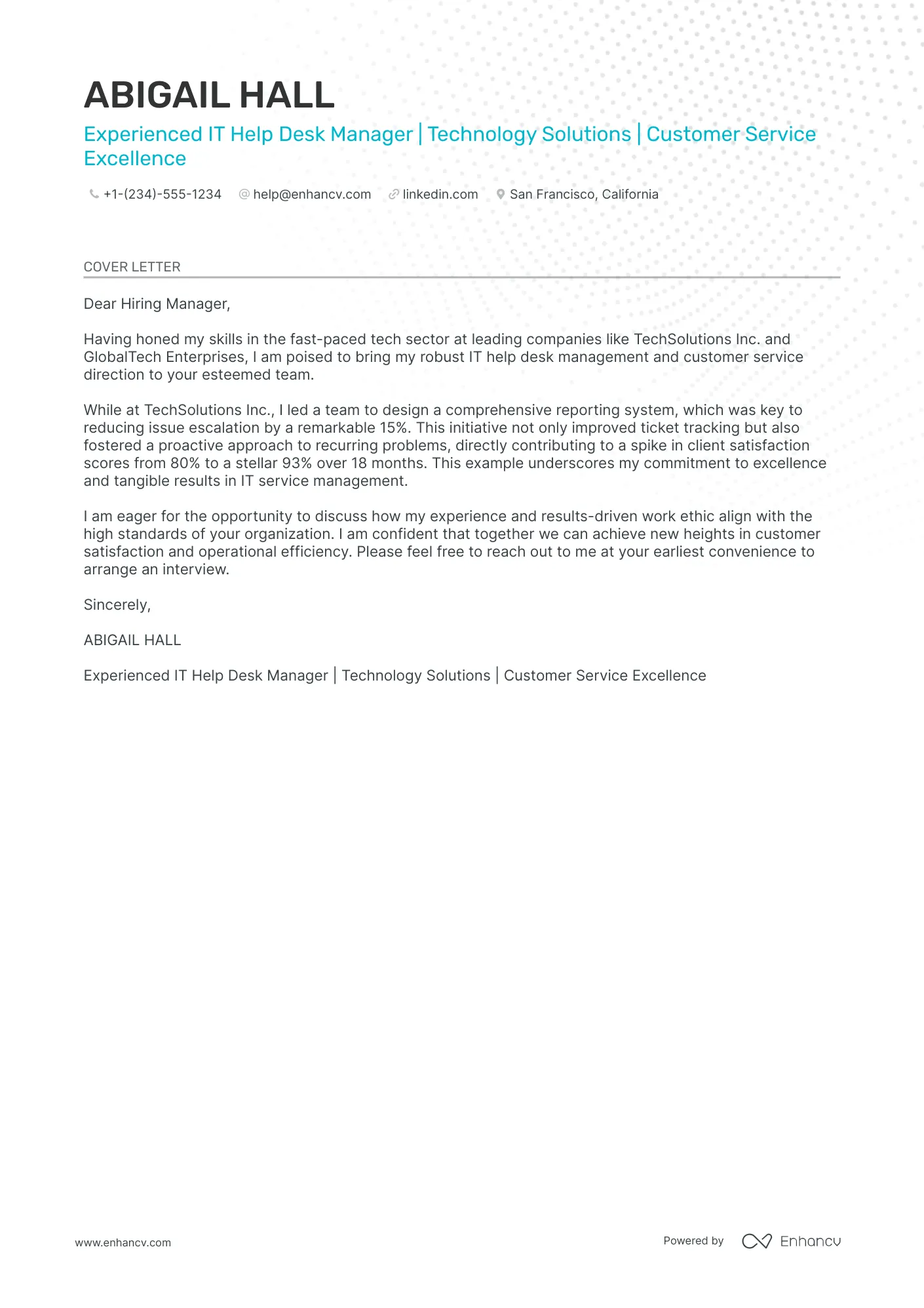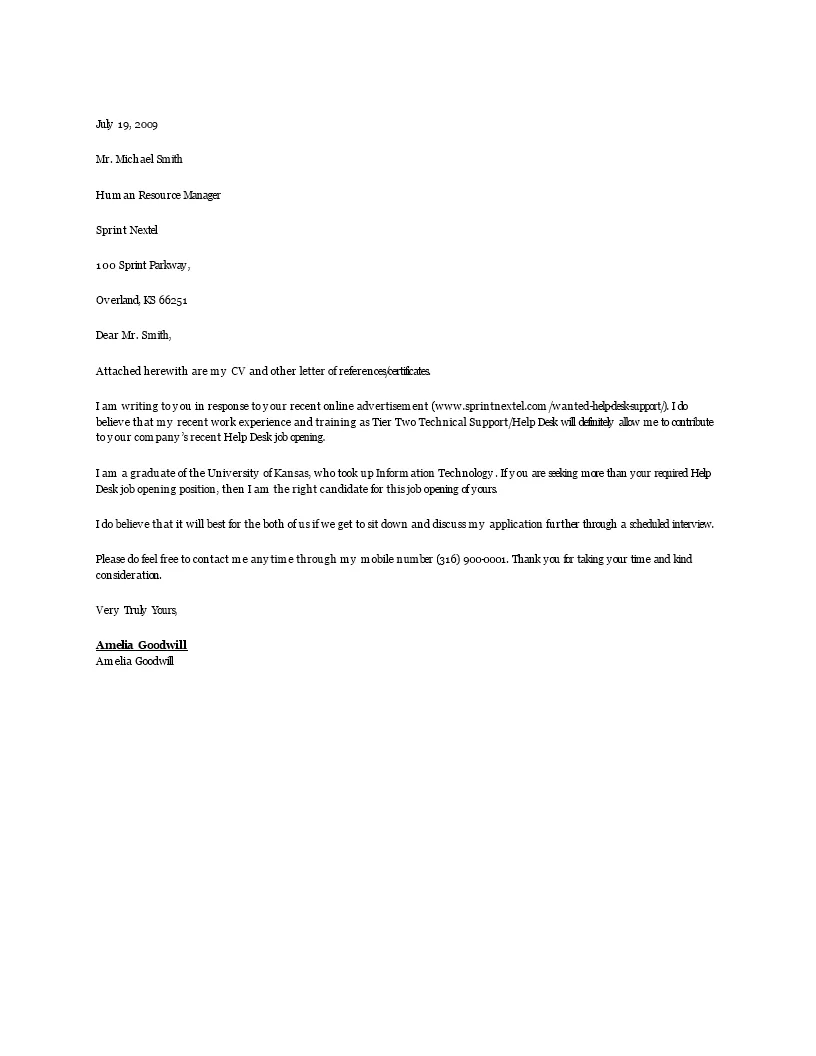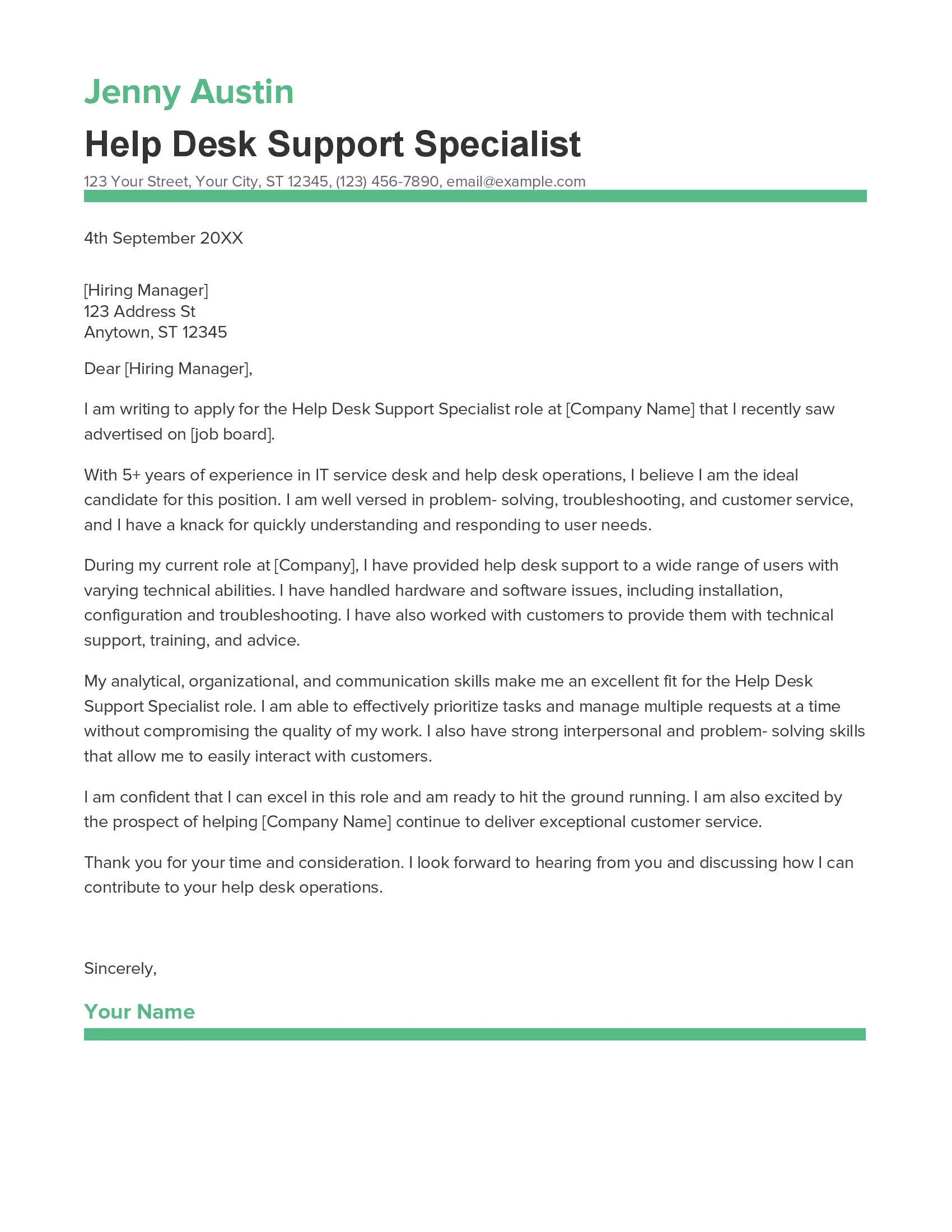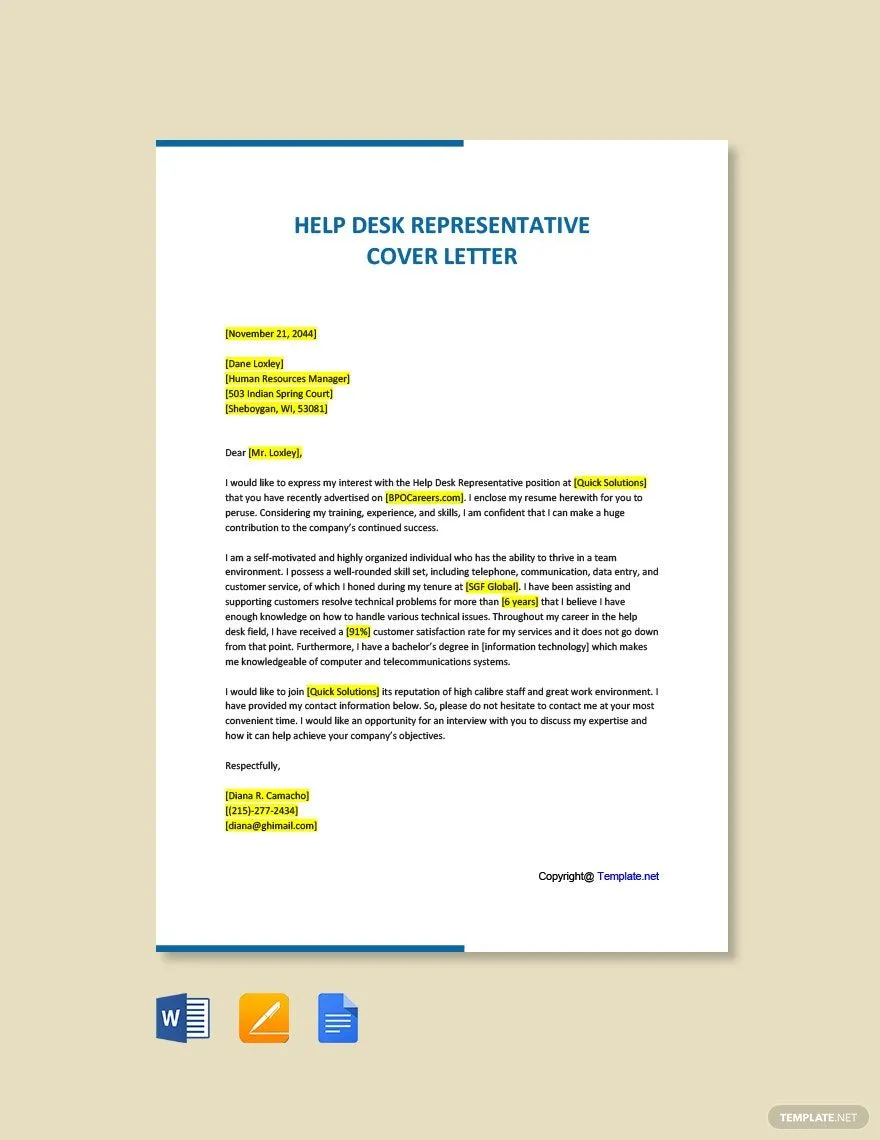Understanding the Importance of a Help Desk Cover Letter
In the competitive world of IT support, a well-crafted help desk cover letter can be your golden ticket to landing an interview. This document serves as your first impression, allowing you to introduce yourself and highlight your relevant skills and experience. Unlike your resume, a cover letter gives you the opportunity to provide context, showcase your personality, and explain why you’re the perfect fit for the specific role and company. It’s a crucial tool in demonstrating your genuine interest and differentiating yourself from other applicants. A strong cover letter doesn’t just reiterate your resume; it tells a story, illustrating how your abilities align with the job’s requirements and the company’s culture. Ignoring this step means missing out on a valuable opportunity to make a lasting positive impact on the hiring manager and potentially secure your dream job.
Key Components of a Help Desk Cover Letter
A compelling help desk cover letter is structured logically and includes essential elements. These components work together to create a persuasive narrative, convincing the hiring manager of your qualifications. Begin with a professional heading and personalized salutation, showing attention to detail and respect. The body should be well-organized, breaking down your skills, experience, and enthusiasm for the role. Use clear, concise language and quantifiable achievements to demonstrate your value. Proofread diligently for any errors in grammar or spelling before submitting your application. A well-structured cover letter can greatly enhance your chances of standing out from the crowd.
Your Contact Information and the Date

Start your cover letter with your full name, address, phone number, and email address in the header. This ensures the recruiter can easily reach you. Below your contact information, include the date you’re sending the letter. Make sure the date is formatted correctly to follow a standard, professional format.
The Hiring Manager’s Contact Information
Whenever possible, address the hiring manager directly by name. Research the company’s website, LinkedIn, or job posting to find the name of the person responsible for hiring. If you can’t find a specific name, use a professional salutation like “Dear Hiring Manager.” Always research the best contact information for the hiring manager to make sure the letter goes to the right person.
A Compelling Opening
Your opening paragraph should grab the reader’s attention immediately. State the position you’re applying for and where you saw the job posting. Briefly explain why you’re interested in the role and the company. Mention something specific that excites you about the opportunity, such as the company’s mission, a recent project, or a value they uphold. Avoid generic introductions. Instead, highlight your enthusiasm and a key skill relevant to the job.
Highlighting Relevant Skills and Experience

The core of your cover letter should showcase your qualifications, aligning them with the job’s requirements. Review the job description carefully and identify the key skills and experiences the employer is seeking. Use specific examples from your past roles or projects to demonstrate how you’ve successfully applied these skills. Quantify your achievements whenever possible, such as the number of tickets resolved, the percentage of customer satisfaction improvement, or any cost savings you’ve achieved. Use strong action verbs to describe your accomplishments and show your capabilities. Tailor your examples for each application to match the specific job’s needs.
Technical Skills to Showcase
Help desk roles demand a range of technical skills. Highlight your proficiency in areas such as troubleshooting hardware and software issues, network configuration, operating systems (Windows, macOS, Linux), and ticketing systems. Mention any relevant certifications, such as CompTIA A+, Network+, or Microsoft certifications. Detail your experience with remote support tools, IT security protocols, and data backup and recovery. Provide specific examples of technical issues you have resolved and the tools and methods you used. Show that you are capable of efficiently diagnosing and resolving technical problems.
Soft Skills for Help Desk Roles
While technical skills are essential, help desk positions also rely heavily on soft skills. Emphasize your communication, problem-solving, and customer service abilities. Demonstrate your ability to explain complex technical issues to non-technical users in a clear and understandable manner. Highlight your active listening skills and empathy in dealing with user issues. Showcase your ability to work under pressure, manage your time effectively, and collaborate with team members. Provide instances where you have resolved a difficult customer situation or handled a stressful situation effectively.
Quantifying Your Achievements

Whenever possible, quantify your achievements to make your claims more impactful. Instead of stating that you improved customer satisfaction, mention the percentage increase. Instead of saying you resolved many tickets, specify the number of tickets you addressed daily or weekly. Quantifiable data provides concrete evidence of your abilities and accomplishments. Use metrics like response times, resolution rates, or the reduction of downtime to showcase your value. Providing measurable outcomes strengthens your cover letter and makes your application much more convincing.
Tailoring Your Cover Letter
Avoid sending a generic cover letter for every job application. Tailor your letter to each specific role and company. This shows the hiring manager that you have done your research and genuinely want the position. Review the job description thoroughly and identify the most important skills and experiences the employer seeks. Customize your letter to highlight these qualifications and use examples that demonstrate your alignment with the requirements. Tailoring helps you stand out as a candidate by showcasing your relevance.
Researching the Company
Before writing your cover letter, research the company. Understand their mission, values, and recent projects. This information helps you tailor your letter to reflect your interest in the organization specifically. Browse their website, read news articles about the company, and review their social media profiles. Use this research to demonstrate your knowledge and express why you’re interested in working there. Showing that you understand their business and culture indicates a genuine interest and adds credibility to your application. Make sure to find the best contact information to address the hiring manager and increase your chances to be read.
Matching Skills to Job Requirements

Carefully compare your skills and experience with the job requirements listed in the job description. Identify the keywords and qualifications the employer prioritizes. In your cover letter, clearly demonstrate how your skills and experience align with these requirements. Use the same language as the job description and provide examples of how you have successfully performed the tasks outlined. Make a direct connection between your qualifications and the needs of the role. This makes it easier for the hiring manager to understand that you are a well-matched candidate.
Proofreading and Formatting
Ensure your cover letter is free of errors in grammar, spelling, and punctuation. Errors can create a negative impression and damage your credibility. Proofread your letter carefully, using spell-check and grammar-check tools. Have someone else review your letter to catch any mistakes you might have missed. Use a clean, professional font like Arial, Calibri, or Times New Roman. Use a readable font size and spacing. Keep the letter concise and easy to read, with clear paragraphs and adequate white space. Good formatting shows attention to detail and respect for the reader’s time. You should always use the best formatting when submitting a help desk cover letter.
Common Mistakes to Avoid
Many applicants make common mistakes that can undermine their cover letter and reduce their chances of success. Awareness of these errors can help you avoid them and create a strong application. The best help desk cover letter is always well written and free of errors. By avoiding these mistakes you can greatly increase your chances of landing an interview.
Grammar and Spelling Errors

One of the most common mistakes is making grammar and spelling errors. Always carefully proofread your cover letter before submitting it. Errors can detract from your professionalism and make a bad impression. Use spell-check and grammar-check tools, and have someone else review the letter. Ensure the language is clear, concise, and error-free. Proofreading shows attention to detail and respect for the hiring manager’s time.
Generic Cover Letters
Submitting a generic cover letter is another common mistake. A generic letter does not show that you have done your research on the company or that you are truly interested in the position. The hiring manager can easily tell if you’ve simply used a template. Customize your cover letter for each job application, tailoring it to the specific role and company. Highlight the skills and experiences that are most relevant to the job requirements. Showing you understand the company’s mission and culture will make you stand out.
Length and Tone
Keep your cover letter concise, ideally no more than one page. Long, rambling letters can lose the reader’s interest. Use a professional and confident tone, but avoid sounding overly formal or arrogant. Be enthusiastic and express your interest in the role. Use clear and straightforward language to convey your message. You should always maintain a respectful tone and keep the letter at an appropriate length. These best practices will help to make your letter as effective as possible.
Closing Your Cover Letter

The closing of your cover letter is a crucial opportunity to leave a lasting impression. Make sure it’s both professional and engaging, encouraging the hiring manager to take the next step.
Expressing Enthusiasm
Reiterate your enthusiasm for the position and the company in your closing paragraph. Reaffirm why you’re interested and how your skills and experience align with the role’s needs. Avoid generic phrases and personalize the message, reflecting what specifically excites you about the opportunity. This will help make sure the hiring manager remembers you and your unique capabilities.
Call to Action
Conclude your cover letter with a clear call to action. Express your availability for an interview and provide your contact information again. State that you are eager to discuss the opportunity further. Thank the hiring manager for their time and consideration. Use a professional closing, such as “Sincerely” or “Best regards,” followed by your full name. A strong call to action motivates the hiring manager to move forward with your application.
